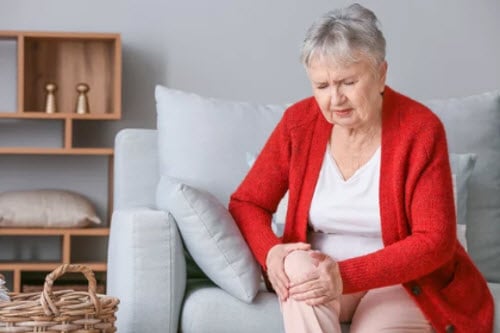
Osteoarthritis Knee Pain
Osteoarthritis knee pain is a common condition that affects millions of people worldwide. It is a degenerative joint disease that primarily affects the knee joint, causing pain, stiffness, and reduced mobility. Also known as degenerative arthritis or wear-and-tear arthritis, osteoarthritis is the most common form of arthritis and is more prevalent among older adults.
As the name suggests, osteoarthritis knee pain occurs when the protective cartilage on the ends of the bones in the knee joint gradually wears away over time. This leads to bone-on-bone contact, resulting in pain, inflammation, and difficulty in performing everyday activities.
Individuals with osteoarthritis knee pain often experience symptoms such as joint stiffness, swelling, tenderness, and a grating sensation when moving the knee. The severity of the symptoms can vary from mild to severe, and they tend to worsen over time. In advanced stages of the condition, individuals may experience chronic pain and significant limitations in their ability to walk, climb stairs, or engage in physical activities.
Osteoarthritis knee pain is typically caused by a combination of factors, including age, genetics, previous knee injuries, obesity, and repetitive stress on the knee joint. Over time, the constant wear and tear on the knee joint leads to the breakdown of cartilage and the development of osteoarthritis.
Understanding the causes, symptoms, and stages of osteoarthritis knee pain is crucial for effective management and treatment. In the following sections, we will explore the different stages of the condition, its typical causes, and the risk factors associated with it. We will also delve into how chiropractic care can help alleviate the pain and discomfort associated with osteoarthritis knee pain, as well as some self-relief methods that individuals can try at home. Lastly, we will discuss when it is necessary to seek medical attention for this condition.
Symptoms & Different Stages of Osteoarthritis Knee Pain
Osteoarthritis knee pain is a debilitating condition that can significantly impact a person’s quality of life. It is important to be aware of the symptoms and different stages of this condition to seek appropriate treatment and manage the pain effectively.
- Early Stage: In the early stages of osteoarthritis knee pain, individuals may experience mild discomfort and stiffness in the knee joint. This may be more noticeable after periods of inactivity, such as when getting out of bed in the morning or after sitting for a prolonged period. There may also be a slight decrease in flexibility and range of motion.
- Moderate Stage: As the condition progresses to the moderate stage, the pain and stiffness in the knee joint become more pronounced. Individuals may experience difficulty with activities that involve bending or straightening the knee, such as climbing stairs or getting in and out of a car. Swelling and inflammation may also be present.
- Advanced Stage: In the advanced stage of osteoarthritis knee pain, the pain becomes constant and severe. The joint may become visibly deformed, and there may be a significant loss of function. Activities of daily living, such as walking or standing, become extremely challenging and may require the use of assistive devices, such as a cane or walker.
It is important to note that the progression of osteoarthritis knee pain can vary from person to person. Some individuals may experience a slow and gradual progression, while others may have a more rapid deterioration of the joint. It is essential to listen to your body and seek medical attention if you experience any of the following:
- Severe and persistent pain that does not improve with rest or over-the-counter pain medications
- Swelling, redness, or warmth in the knee joint
- Limited range of motion that significantly impacts daily activities
- Instability or feeling of giving way in the knee
If you experience any of these symptoms, it is important to consult with a healthcare professional who can provide a proper diagnosis and recommend appropriate treatment options. Early intervention and management can help slow the progression of osteoarthritis knee pain and improve overall function and quality of life.

Most Common Causes of Osteoarthritis Knee Pain
Osteoarthritis knee pain is a debilitating condition that affects millions of people worldwide. It occurs when the protective cartilage in the knee joint wears down over time, leading to pain, stiffness, and reduced mobility. While there is no single cause for osteoarthritis knee pain, several factors can contribute to its development. Here are some of the most common causes:
- Age: As we age, the risk of developing osteoarthritis knee pain increases. The wear and tear on the knee joint over the years can lead to the breakdown of cartilage.
- Obesity: Excess weight puts added stress on the knee joints, accelerating the degeneration of cartilage. This can lead to the development of osteoarthritis knee pain at an earlier age.
- Joint injuries: Previous injuries to the knee, such as ligament tears or fractures, can increase the likelihood of developing osteoarthritis knee pain later in life. These injuries may disrupt the normal functioning of the joint and cause cartilage damage.
- Genetics: Some individuals may have a genetic predisposition to developing osteoarthritis knee pain. If a close family member has the condition, the risk of developing it is higher.
- Occupational factors: Certain occupations that involve repetitive knee movements or kneeling, such as construction work or professional sports, can increase the risk of developing osteoarthritis knee pain.
It’s important to note that while these factors can increase the likelihood of developing osteoarthritis knee pain, they do not guarantee its occurrence. Each individual’s experience with the condition may vary, and other factors may also play a role in its development.
The Consequences of Allowing Osteoarthritis Knee Pain to Progress
Ignoring or neglecting osteoarthritis knee pain can have severe consequences on an individual’s quality of life. If left untreated, this condition can worsen over time, leading to:
- Increased pain and discomfort: As osteoarthritis progresses, the pain in the affected knee can intensify, making it difficult to perform daily activities such as walking, climbing stairs, or even standing for extended periods.
- Joint stiffness: The knee joint may become increasingly stiff, making it challenging to bend or straighten the leg fully. This stiffness can further limit mobility and hinder participation in physical activities.
- Decreased range of motion: Osteoarthritis can gradually reduce the knee’s range of motion, making it harder to perform simple movements like bending the knee or fully extending it. This limitation can impact one’s ability to engage in various physical activities.
- Joint instability: As the condition progresses, the knee joint may become less stable, leading to a feeling of weakness or giving way. This instability can increase the risk of falls and further damage to the knee.
- Muscle weakness: Chronic knee pain and limited mobility can cause the muscles surrounding the knee to weaken over time. This muscle weakness can further exacerbate the pain and affect overall leg strength.
- Reduced quality of life: The combination of persistent pain, limited mobility, and decreased ability to engage in daily activities can significantly impact an individual’s overall quality of life. It may lead to feelings of frustration, depression, and social isolation.
It is crucial not to underestimate the potential consequences of allowing osteoarthritis knee pain to progress. Seeking appropriate treatment and management strategies, such as chiropractic care, can help alleviate symptoms, slow down the progression of the condition, and improve overall knee function.
Chiropractic for Osteoarthritis Knee Pain
Chiropractic care is a holistic approach that focuses on the body’s natural ability to heal itself. When it comes to osteoarthritis knee pain, chiropractic treatment can provide significant relief and improve the overall quality of life for individuals suffering from this condition.
- Joint manipulation: Chiropractors are skilled in performing gentle joint manipulations to restore proper alignment and mobility to the affected knee joint. This technique can help reduce pain, inflammation, and stiffness.
- Soft tissue therapy: Chiropractors may also use soft tissue therapy techniques such as sports massage Singapore or myofascial release to alleviate muscle tension and improve blood circulation around the knee joint. This can promote healing and reduce pain.
- Exercise and stretching: Chiropractors often prescribe specific exercises and stretches to strengthen the muscles around the knee joint and improve flexibility. These exercises can help support the joint, reduce stress on the affected area, and enhance overall function.
- Lifestyle modifications: Chiropractors can provide guidance on lifestyle modifications that can help manage osteoarthritis knee pain. This may include recommendations on weight management, proper nutrition, and ergonomic adjustments to reduce stress on the knee joint.
- Collaborative approach: Chiropractors work closely with other healthcare professionals, such as physical therapists and orthopedic specialists, to develop a comprehensive treatment plan for osteoarthritis knee pain. This collaborative approach ensures that patients receive the most effective and personalized care.
It is important to note that chiropractic care may not be suitable for all individuals with osteoarthritis knee pain, especially in advanced stages of the condition. It is always recommended to consult with a chiropractor or healthcare provider to determine the most appropriate treatment options based on individual needs and medical history.

Self-Help & Relief for Osteoarthritis Knee Pain
While chiropractic care can greatly assist in managing osteoarthritis knee pain, there are also self-help methods that patients can explore to alleviate their discomfort. These self-relief techniques can be used in conjunction with chiropractic treatments to provide additional relief and improve overall well-being.
- Exercise: Engaging in regular low-impact exercises can help strengthen the muscles surrounding the knee joint and reduce pain. Activities such as swimming, cycling, and walking are gentle on the joints while still providing the necessary movement for maintaining joint flexibility and reducing stiffness.
- Weight management: Maintaining a healthy weight is crucial for individuals with osteoarthritis knee pain. Excess weight puts additional stress on the knee joints, exacerbating the pain and causing further damage. By adopting a balanced diet and engaging in regular physical activity, patients can effectively manage their weight and reduce the burden on their knees.
- Hot and cold therapy: Applying heat or cold to the affected knee can help alleviate pain and reduce inflammation. Heat therapy, such as using a warm towel or taking a warm bath, can help relax the muscles and increase blood flow to the area. Cold therapy, on the other hand, can numb the pain and reduce swelling. Patients can use ice packs or cold compresses for this purpose.
- Assistive devices: Utilizing assistive devices, such as braces, can provide additional support to the knee joint and help reduce pain. These devices help stabilize the knee and limit excessive movement, allowing for improved mobility and reduced discomfort.
- Proper footwear: Wearing comfortable and supportive footwear can significantly alleviate knee pain associated with osteoarthritis. Shoes with cushioning and arch support help distribute the body’s weight more evenly, reducing the strain on the knee joints.
- Relaxation techniques: Incorporating relaxation techniques, such as deep breathing exercises or meditation, can help manage the stress and anxiety that often accompany chronic pain. By reducing stress levels, patients may experience a decrease in pain intensity and an improvement in overall well-being.
It is important to note that while these self-help methods can provide temporary relief, they may not address the underlying cause of the osteoarthritis knee pain. Therefore, it is recommended to consult with a chiropractic health expert or a healthcare professional for a comprehensive evaluation and personalized treatment plan.
When to Seek Medical Help for Osteoarthritis Knee Pain
Living with osteoarthritis knee pain can be challenging, affecting your daily activities and overall quality of life. While there are self-relief methods that can provide temporary relief, it is important to recognize when it is time to seek medical help. Enduring and living with chronic pain is not okay, and some professionals can help you manage your condition effectively.
If you experience any of the following, it is recommended to consult a healthcare professional:
- Severe and persistent knee pain that limits your mobility and interferes with your daily activities
- Swelling, redness, or warmth around the knee joint
- Difficulty bearing weight on the affected knee
- Noticeable deformity or instability in the knee joint
- Gradual worsening of symptoms over time
- Signs of infection, such as fever, chills, or increased pain
Remember, seeking medical help does not mean you have to immediately opt for invasive treatments or surgery. A healthcare professional, such as a chiropractor, can assess your condition, provide a proper diagnosis, and develop a personalized treatment plan to address your specific needs.
Early intervention and appropriate management can help slow down the progression of osteoarthritis, alleviate pain, and improve your overall knee function. So, don’t hesitate to reach out to a medical professional who specializes in treating joint conditions like osteoarthritis knee pain. They have the knowledge and expertise to guide you towards a better quality of life.

Dr. Jenny Li is America trained chiropractor who specialises in sports injury, sports performance, and spinal health. She graduated from Palmer College of Chiropractic in United States, upon completion of the her post graduate program she practiced in Hong Kong and currently is practicing in Singapore.

